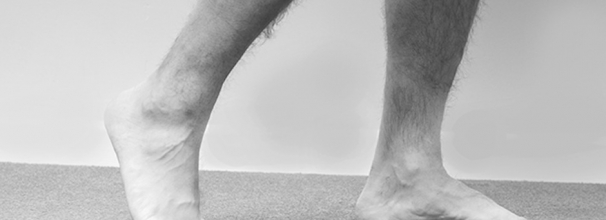In my experience, walking is the most common activity that clients want to get back to after a neurological injury. It’s not surprising considering that we walk in order to achieve most tasks we do throughout the day. Those who are able to return to walking following stroke more often than not find that their walking is slower and asymmetrical. I want to use this blog to talk about a couple of common problems that impact on walking following stroke: foot drop and knee hyperextension. For each problem I will explain what causes it, and give examples of treatment that may be used. These two problems are by no means exhaustive as there are far more problems which impact on walking. It is more an introduction to a couple of walking problems following stroke. I hope that it is a useful resource.
1) Foot drop
This is a very common problem and it refers to weakness of the muscles on the front of the lower leg (called ankle dorsiflexors), which are responsible for pulling your toes up towards your head. As with any muscle weakness following stroke, the severity varies between individuals. You may have a mild weakness, and find that your toes catch on the ground occasionally when you have walked a long distance, or you may not be able to lift your toes at all. If the weakness is severe, you may find that you compensate for it by lifting your knee up towards your chest, so that your foot does not catch the floor. The treatment for foot drop varies depending on the severity of it. If you are unable to clear your toes then it may be appropriate to wear an ankle foot orthosis. This is commonly referred to as an AFO. An AFO is a splint, which helps to support the ankle joint during walking. There are a huge variety of AFO’s available on the market, being made from different materials. An AFO should always be fitted/ prescribed by a trained therapist. Another treatment which is available is functional electrical stimulation (referred to as FES). With FES an electrical current is used to stimulate the ankle dorsiflexors to contract and clear the toes from the floor. Again there are many companies which produce these machines and you should be assessed by a trained therapist.
Exercise is very important for the treatment of foot drop. Strengthening exercises for the ankle dorsiflexors with or without the use of equipment, such as theraband, may be appropriate. Stretching of the calf muscles is often important, as increased tone in these muscles and stiffness can compound foot drop. Gait (walking) retraining is also a key part, so you may need to focus on a specific part of the walking cycle in order to improve your walking.
2) Knee hyperextension
This is another common problem that is seen when bearing weight on the affected leg. The knee will be seen to overextend (straighten). This usually occurs due to muscle weakness of the knee. There are two main muscle groups at the knee joint, the quadriceps (which run down the front of the thigh) and the hamstrings (which run down the back of the thigh). The quadriceps straighten and the hamstrings bend the knee. Weakness of either of these muscle groups can cause reduced stability at the knee in walking. Knee hyperextension is often associated with pain. Treatment of this problem will involve lots of strengthening exercises, and working in different positions in order to activate the weaker muscles.
Repetitive practice is the key for all functional recovery following stroke. It is the same for walking, – the more you walk, the more likely your walking is to improve.






Pingback: Why is hyperextension found in people with neurological damage? - Quora